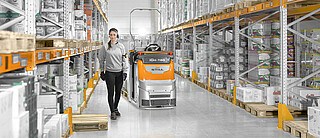STILL’s Partnership with Dematic and the Future of Warehouse Automation

What is the nature of the partnership between STILL and Dematic and how does this help your clients?
Hubertus Wabnitz, STILL Head of Operations Management Advanced Applications:
"In general, we distinguish between stationary and mobile automation. At STILL we provide elements which are categorised as mobile automation, such as our automated and autonomous industrial trucks, directly to our customers. For elements of stationary automation, such as conveyor systems, stacker cranes or palletizing equipment we partner with our sister company Dematic.
Dematic are one of the world's leading providers of integrated automation technology, software and services for optimising the supply chain. By partnering with them we are able to offer our customers an almost complete portfolio in the area of in-plant automation solutions."

How do STILL and Dematic's services and areas of expertise integrate?
Hubertus Wabnitz, STILL Head of Operations Management Advanced Applications:
"There are cases where STILL and Dematic work jointly and in partnership with the customer. This often happens with a combination of stationary automation and automated trucks. However, depending on the customer's technical requirements, the collaboration can also lead to a mutual referral. We aim to support the customer in finding the optimal solution, regardless of who delivers it.
For example, in one of our latest projects, STILL developed an independent logistics consultancy concept, which resulted in an AutoStore system. In the tender process, Dematic came out on top as the supplier of the AutoStore system with STILL being the supplier of conveyors, racking and shelving. Dematic then took the lead in the implementation as the main supplier which worked seamlessly."
How has the concept of Industry 4.0 impacted the materials handling industry?
Rhea Langkammer, STILL Head of Marketing Business Line A&S:
"The concept of Industry 4.0 aims to completely transform production, but also warehouse logistics. At the core of Industry 4.0 are two key developments: digital networking and autonomous systems to optimise entire value chains.
People, machines, software tools and products are all networked together with the sole purpose of exchanging data. The goal for the materials handling industry is to use and combine this data by using new technologies to improve performance and efficiency.

How is STILL contributing to Industry 4.0 developments?
Rhea Langkammer, STILL Head of Marketing Business Line A&S:
"At STILL we are focused on driving forwards the future of intralogistics. For example, we are taking part in the development of a standard interface for automated guided vehicles (AGVs). The interface is being developed in cooperation with the German Association of the Automotive Industry and the VDMA Association for Materials Handling and Intralogistics.
The ambition is to create a universally applicable interface to simplify the future connection of new vehicles to an existing control centre. Having a universal interface would enable parallel operation with AGVs (Automated Guided Vehicles) from different manufacturers and integration with multiple systems.
We are playing a significant and active role in the development of this standardised master control system to meet the requirements of our customers. The aim is to be able to exchange the vehicles within the intralogistics processes in order to become even more transparent and overcome the hurdles on the way to automation."
What part does warehouse automation have to play in Industry 4.0?
Comments
No comments
Need more help on these topics? Contact our professional team today.
Noe van Bergen, STILL Head of Automated Solutions:
The topic of data use and data exchange is becoming increasingly important in the field of warehouse automation. Without the use of data, developments in the field of autonomous driving and system optimisation would not be possible.
For AGV systems as an example, STILL offers iGo insights, a cloud-based tool for evaluation that filters correlations from the wealth of data collected and generates recommendations on how to optimise the availability and performance of your system. All data collected by the AGV control system is uploaded to the cloud for analysis and is available online via the web portal.
Our iGo technology uses machine learning insights to improve the performance of the system. The software recognises structures and calculates probabilities in this data history, enabling you to take proactive action - for example, when scheduling maintenance or repairs.
With today’s technology, every warehouse operation has the potential for automation. Sometimes only portions of it, sometimes integrally. The challenge is that there are hundreds of suppliers, start-ups, tech and software companies trying to capture the market in this area.
This can be quite confusing for companies which would like to begin automating their processes. At STILL we are committed to innovations in the area of Industry 4.0 and automation as part of various research projects and in-house developments. Nevertheless, we are convinced that automation solutions must bring maximum value. Therefore, any innovation must be useful for our customers' requirements, as well as being more profitable."
Noe van Bergen, STILL Head of Automated Solutions:
"The rise of Industry 4.0 in warehousing is massive. The ongoing pandemic demonstrates the requirement for automating and transforming our supply chains and logistics. The focus has long been in digitalising production processes and machinery, but a modern, flexible and scalable logistics chain turns out to be as crucial. Hardly any other solution offers as much potential for process optimisation, data exchange and networking as automated systems do.

We see a trend from standard trucks to digitalised versions, where additional software features, assist operators to work more efficiently and reliably, and this extends even further, where the machines drive completely automatically by themselves. On top of this, cloud solutions and AI driven data analysis create opportunities to build new services and business models that adds value for customers and makes their processes even more efficient."
Subscribe to the blog !
Be informed as soon as an article is published. You can unsubscribe anytime.

Leave a comment